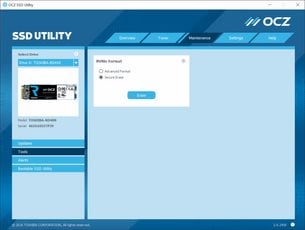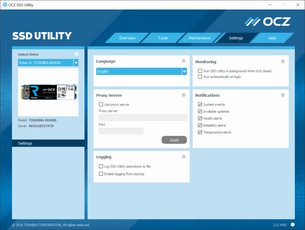Toshiba OCZ RD400 Series High-Performance NVMe SSD Review
It took a bit of tweaking and fine tuning to get the drive ready for market, but it’s here now, and as you’ll see on the pages ahead, the RD400 was worth the short wait.
Like the last couple of OCZ solid state drives we’ve looked at recently, the new RD400 is packing all Toshiba-made, proprietary technology. The NAND, controller, and firmware are all baked in-house. The specifications for the entire family of drives is laid out for you below, followed by some up-close-and-personal pics of the RD400, and then of course, a full suite of benchmark scores...
|
| Performance | 128 GB | 256 GB | 512 GB | 1024 GB |
| Sequential Reads | Up to 2,200 MB/s | Up to 2,600 MB/s | Up to 2,600 MB/s | Up to 2,600 MB/s |
| Sequential Writes | Up to 620 MB/s | Up to 1,150 MB/s | Up to 1,600 MB/s | Up to 1,550 MB/s |
| Random Read (4KiB) | Up to 170,000 IOPS | Up to 210,000 IOPS | Up to 190,000 IOPS | Up to 210,000 IOPS |
| Random Write (4KiB) | Up to 110,000 IOPS | Up to 140,000 IOPS | Up to 120,000 IOPS | Up to 130,000 IOPS |
| Endurance | ||||
| TBW | 74 TB | 148 TB | 296 TB | 592 TB |
| Daily Usage Guidelines | 40 GB/day | 81 GB/day | 162 GB/day | 324 GB/day |
| Physical | |
| Usable Capacities | 128 GB, 256 GB, 512 GB, 1024 GB |
| Form Factor | M.2 2280, M.2 2280+AIC |
| Interface | PCI Express Base Specification Revision 3.1 (PCIe) Maximum Speed: 32 GT/s (PCIe Gen3x4L ) Command: NVM Express Revision 1.1b (NV |
| NAND Flash Memory Type | MLC |
| Dimension (L x W x H) | 128 GB, 256 GB, 512 GB: 80 x 22 x 2.23 mm, 1024 GB: 80 x 22 x 3.58 mm, AIC: 157.64 x 105.51 x 17.2 mm |
| Drive Weight | 128 GB: 6.8g (typ.), 256 GB, 512 GB: 7.2g (typ.), 1024 GB: 8.6g (typ.) AIC: 63 g (typ.) |
| Power Requirements | |
| Supply Voltage | 128 GB, 256 GB, 512 GB, 1024 GB: 3.3 V +/- 5% AIC: 12 V +/- 5% |
| Power Consumption 1 | (Active) 128 GB, 256 GB, 512 GB: 6.0 W (typ.), 1024 GB and AIC: 6.4 W (typ.) |
| Power Consumption 2 | (Power State) 128 GB, 256 GB, 512 GB, 1024 GB and AIC: 6.0 mW (typ.) |
| Environmental | |
| Operating Temperature | 0°C to 70°C |
| Storage Temperature | -40°C to 85°C |
| Shock Resistance | 9.8 km/s2 {1000 G} (0.5 ms) |
| Vibration | Operational 21 m/s2 {2.17 Grms} (Peak, 7 to 800 Hz) Non-operational 30 m/s2 {3.13 Grms} (Peak, 5 to 800 Hz) |
| Certifications | UL/cUL, FCC, CE, RCM, KC, BSMI, VCCI, and ISED |
| Reliability / Security | |
| MTBF | 1.5M hours |
| Health Monitoring | Self-Monitoring, Analysis and Reporting Technology (SMART) Support |
| Compatibility | |
| PCI Express | Compatible with PCI Express Base Specification Revision 3.1 |
| Operating System | Windows 10, Windows 8.1, Windows 7, Linux Fedora 21, Mint 17.1, ElementaryOS Freya, OpenSUSE 13.2, Ubuntu 14.04, Ubuntu 14.10, Mac OS X 10.9, 10.10, 10.11 |
| Connector Type | M.2: M.2 M key socket, AIC: PCIe slot |
| Pricing | 128GB - 1TB Capacities: $129.99 - $739.99 - $309 (512GB) and $739 (1TB) As Tested |
The Toshiba OCZ RD400 NVMe SSD will be available in a variety of capacities and form factors. The drives will be sold as PCIe add-in cards or standalone gum-stick drives, with capacities ranging from 128GB on up to 1TB.
Peak sequential bandwidth ranges from 2.2GB/s on the 128GB drive on up to 2.6GB/s on the larger capacities. Writes on the 128GB drive top out at 620MB/s, 1.15GB/s on the 256GB drive, 1600MB/s on the 512MB drive and 1550MB/s on the 1TB drive. We’ve got the 512GB and 1TB drives in house, so the fastest of the RD400s will be put to the test here.
The actual RD400 drives feature Toshiba 15nm MLC NAND flash memory and a Toshiba-made controller. Unfortunately, no details were given on the controller, but it is a native PCIe 3.1 device that’s NVM Express Revision 1.1b compliant. The drives themselves conform to the M.2 2280 “gum-stick” form factor, and feature PCIe Gen3x4 electrical connections (32GT/s peak).
Endurance ratings on the drives range from 74TB total bytes written (TBW) on the 128GB drive on up to 592 TB on the 1TB drive. That works out to 40GB per day on the 128GB drive and 324GB/s on the 1TB drive – the 256GB, 512GB drives fall in between.
We should also mention that OCZ offers a 5 year warranty on these SSDs. And that warranty is of the AWP – or Advanced Warranty Program – variety. With an AWP-class warranty, users simply have to submit the drive’s serial number (no original purchase receipt is required), and in the event the drive is determined to be defective, it will be replaced with a brand new SSD, that’ll ship within one business day.
The Toshiba OCZ RD 400 is also compatible with the company’s SSD Utility. The SSD Utility is organized into a handful of intuitive menus: Overview, Tuner, Maintenance, Settings and Help. On the Overview page, users have access to a wealth of data about the drive, including health and usage statistics. On the Tuner page, users can tweak things like over-provisioning or send a TRIM (Optimize in Windows 10) command to the drive. There are options on the tuner page for tweaking OS settings as well (when needed – nothing was listed for the RD400). On the Maintenance page, users can update the drive’s firmware or secure erase the drive, and on the Settings page users will find monitoring and logging options. Help is obviously where users can find information about the tool, but there is contextual help available throughout the utility as well.
Let's take a look our test setup and then we'll get right to performance, next.













